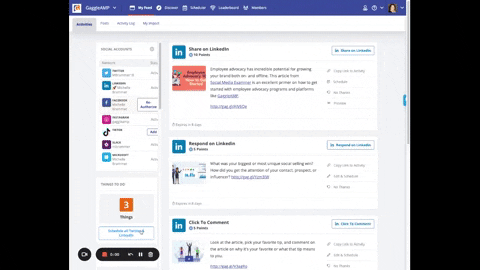Content Marketing on LinkedIn: Strategies to Grow Your Brand
When you hear the words “increase audience engagement,” what is your reaction? Do you immediately think, “Oh no, this is going to cost me a huge chunk of my marketing budget, or I don’t have the staff to devote to it?”
Well, if it’s any consolation, you’re not alone. But guess what? 44% of marketing teams use social media, making it the top marketing channel for marketers. Rather than depending solely on paid marketing distribution, content marketers build a content marketing strategy to create and distribute content directly to their audience to increase engagement.
By implementing a solid content marketing Linkedin strategy, engaging your audience doesn’t have to be complicated, time-consuming, or expensive.
In this post, we’ll walk you through how content marketing works on LinkedIn, the benefits of LinkedIn as a content marketing channel, how to create a content marketing strategy, and five content ideas for LinkedIn.
What Is Content Marketing?
Content marketing is a marketing strategy that brands use to create original, relevant content for their audiences. 1 in 3 brands use content marketing as a core marketing channel, and the most popular media formats are videos, blogs, images, infographics, and case studies.
What makes content marketing different from traditional advertising is the primary intent. Content marketing’s intent is to inform and delight its audience, rather than just sell a product or service. By using content marketing to attract (and retain) an audience and establish authority over time, companies can potentially build strong brand recognition, referrals, and leads.
Content Marketing on LinkedIn
47% of all marketers and 96% of B2B marketers use LinkedIn. B2B marketers, in particular, love LinkedIn and rate it the most effective marketing channel to reach their goals.
For marketers, LinkedIn is both a publishing platform and a distribution channel for content marketing. On LinkedIn, content can take the form of newsletters, blog posts, emails, podcasts, social media posts.
By using LinkedIn for their content marketing, brands can:
- Post original content like social media posts and newsletters to the platform.
- Share content from blogs or podcasts that directs people back to the brand’s website or email signup.
What Are the Benefits of Using LinkedIn for Content Marketing?
Brands love content marketing on LinkedIn because it’s the ideal platform for:
1. Targeting Decision-Makers
With LinkedIn’s precise targeting and search capabilities, brands can target decision-makers in specific roles, industries, and locations. By focusing on these decision-makers, they’ll be reaching individuals who are looking for relevant information, products, and services that their company can provide.
2. Creating Content in a Variety of Formats
LinkedIn content is more than just text posts or images. Since LinkedIn’s inception, they’ve added newsletters, articles, PDFs, polls, and video formats to help brands create content that their audiences will love.
3. Sharing Thought Leadership
LinkedIn is an ideal platform for both brands and leaders to establish themselves as thought leaders in their industry. By using LinkedIn’s creator mode to increase their audience reach and influence, brands can build a following as experts on specific topics.
4. Recruiting New Talent (Employer Branding)
Content marketing isn’t just for reaching customers. As a talent hub, LinkedIn is a great place to engage future and current employees by deploying content marketing for your employer brand.
5. Building Groups/Communities
Community-based marketing is on the rise. If your brand has an alumni or membership-based model, LinkedIn provides a great way to nurture communities and share content through their platform.
How to Create a LinkedIn Content Strategy
Content marketing is a marathon, not a sprint. It takes time to earn followers and build trust and engagement. Get started on the right foot by following these seven steps for your LinkedIn company strategy:
1. Research Your Audience
First, define your ideal audience so you know who to target. To create your ideal persona, ask yourself, “What are they looking for on LinkedIn?” “Is it a community?” “Business development?” “Or job opportunities or upskilling?”
Take a little time to research how your audience uses LinkedIn. You can observe your connections’ interactions, or create a post or poll asking them what type of content they want to see.
Doing this research upfront will help you build engagement-worthy content into your strategy from the start.
2. Set Goals
Goals should be the foundation of your LinkedIn content strategy. Decide which outcomes are important to you so that you can put intention behind your content. Common goals for LinkedIn include building brand awareness, generating lead generation and sales, gaining customer loyalty, and boosting talent recruitment.
Once goals are established, you can tie key performance indicators (KPIs) to each goal. For instance, if your goal is to drive leads through your website, then you can measure clicks to landing pages and conversions from your website analytics.
3. Determine Pillar Content and Content Types
Next, outline at least three pillar content topics that you plan to cover. Pillar content is a term that describes overarching topics you will talk about and establish expertise in. For instance, a human resource software provider may choose to talk about workplace trends, HR tools, and HR leadership strategies.
 Source: Vladimir Blagojević
Source: Vladimir Blagojević
Once you’ve identified your pillar content, you’ll have a framework to jump into content ideas for individual posts. (Read ahead for our workflow recommendations and top content ideas!)
Consider what types of LinkedIn content may help you reach your goals (text and image posts, videos, polls, etc.) and what resources you may need to create them.
4. Make a LinkedIn Content Calendar
Creating consistent content for social media is a discipline. It takes effort to create posts and build up a following. To stay strategic and cut down on your time investment, create a LinkedIn content calendar.
Use your calendar as a roadmap to plan out your content by week, month, quarter, and year. Having an idea of when major topics, events, and initiatives need to be posted will help you with writing and scheduling your content posts for maximum productivity.
And it doesn’t have to be complicated; a LinkedIn content calendar can be as simple as a Google Doc Excel spreadsheet or Word document. There are also a number of social media tools designed for team page management, approval processes, or advanced analytics.
5. Create a Content Marketing Workflow
Sometimes companies start off with great ideas for content marketing, but they get tripped up in the execution. That’s why a content marketing workflow needs to be a part of your content marketing strategy.
Before you start a big content marketing campaign on LinkedIn, ask yourself these questions:
- Who will create, edit, and post content?
- If you have content contributors from across the company or outside contributors, how will you ensure that your content meets brand standards and consistent messaging?
- How will you encourage employees and partners to promote your LinkedIn content?
- Who is responsible for responding to comments and messages on LinkedIn?
- How will you collaborate with teams like customer service, sales, and legal for any concerns that arise?
- Do you need a content or project management tool to manage your workflow?
Once you’ve answered these questions, develop a simple content workflow that works for your brand.
If you need help strengthening your employee advocacy on LinkedIn, consider using a LinkedIn employee advocacy tool. And if you need to boost your employee engagement, our tool, GaggleAMP, makes it easy for employees to share and interact with content on LinkedIn (and other social platforms, too).

6. Tailor Your Voice and Content to LinkedIn
If you plan to repurpose social media content across platforms or distribute blog, podcast, or video content, make sure that you’re adapting the content to the platform. First, from a graphic design standpoint, you’ll need to resize any images or videos to LinkedIn’s recommended sizes.
Second, consider your audience on LinkedIn. You may be targeting a different audience (e.g., business executives) so your social media strategy for LinkedIn will be different from other social platforms. In fact, your posts may differ from your consumer-facing content on Facebook, Instagram, or TikTok.
So, it’s smart to leave room for nuances in messaging between channels. Defining your channel voice will help you achieve consistency and create hyper-relevant content that meets your goals.
7. Measure and Adjust
All good content marketing LinkedIn strategies start with goals. After you start publishing content, it’s essential to measure your engagement for your LinkedIn growth strategy to see how you’re performing and make any necessary adjustments.
 Source: Peter Caputa
Source: Peter Caputa
Common KPIs for LinkedIn include clicks, impressions, views, subscribers, leads captured, and follower count and growth.
5 LinkedIn Marketing Ideas for Top Engagement
Once you’ve established your content marketing strategy and workflow, it’s time to jump into content marketing post ideas.
According to HubSpot, these are the top five content types on social media that marketers rate as most effective. Let’s dig into how you can use each one for maximum engagement.
1. Funny Content (80%)
Humor is probably not what comes to mind when you think about LinkedIn, especially when B2B content tends to have a serious tone. But that’s what can make funny content really stand out on LinkedIn. When appropriate, don’t be afraid to show your playful side (e.g., an April Fool’s Day post). Of course, you want to make sure your jokes don’t offend anyone. When done in a fun light-hearted way, making fun of yourself can be LinkedIn gold.
2. Interactive Content (77%)
People love interactive content — there’s an irresistible quality to it. Polls are one particularly great tactic on LinkedIn. Ask a question to engage your followers and learn something in the process.
Posting content like an image carousel can also boost engagement by inviting audiences to swipe through to learn more.
3. Authentic/Behind-the-Scenes Content (68%)
Behind-the-scenes content consistently performs well on LinkedIn. If you manage a company page, don’t just share press releases or post in corporate speak. Instead of using text to say you had a company picnic, add an image with a brief caption. Like they say, a picture is worth a thousand words.
When you have a captivating image, you can build excitement like sharing sneak peeks before a grand opening or product launch.
4. Relatable Content (67%)
LinkedIn can be very niche in certain industries, and one way to approach this is to really lean into it. If your target audience is accountants, it’s okay to post content targeted toward that particular audience. People come to LinkedIn looking for expertise and community on very niche topics and industries. So, hone in on a specific audience and give them relatable content that they’ll understand and love.
5. Content That Reflects Your Brand’s Values (63%)
Brand value content is actually the most popular form of content marketers use, but they only rate it as the fifth most effective.
Here’s why: sometimes these posts can seem performative when they only appear during certain times of the year. For example, your brand may value the environment, but you only share posts of employees recycling or planting trees on Earth Day.
For success, first make sure you have clear and articulated values within your company. Then, find creative ways to spotlight your values throughout the entire year. Use visuals and show ways your company is taking action, like sponsoring a community initiative that reflects your values.
 Source: REI
Source: REI
Take inspiration from these five best-performing content ideas, but don’t limit yourself to just these ideas. Brands also find success posting educational content, industry trends, nostalgic content, and adding their take to new stories and cultural moments. Experiment with different types of posts and adjust your content based on what generates the most engagement.
Don’t Forget to Amplify Your Content
Since content marketing on LinkedIn is inherently social, the most important thing you can do to build your audience and ensure your posts are seen is to amplify your content. Asking your employees to share your posts is an easy way to help your content gain traction.
To give your employee advocacy a boost, consider using a tool like GaggleAMP. GaggleAMP makes it easy for employees to share and engage with content. Schedule a demo today!










